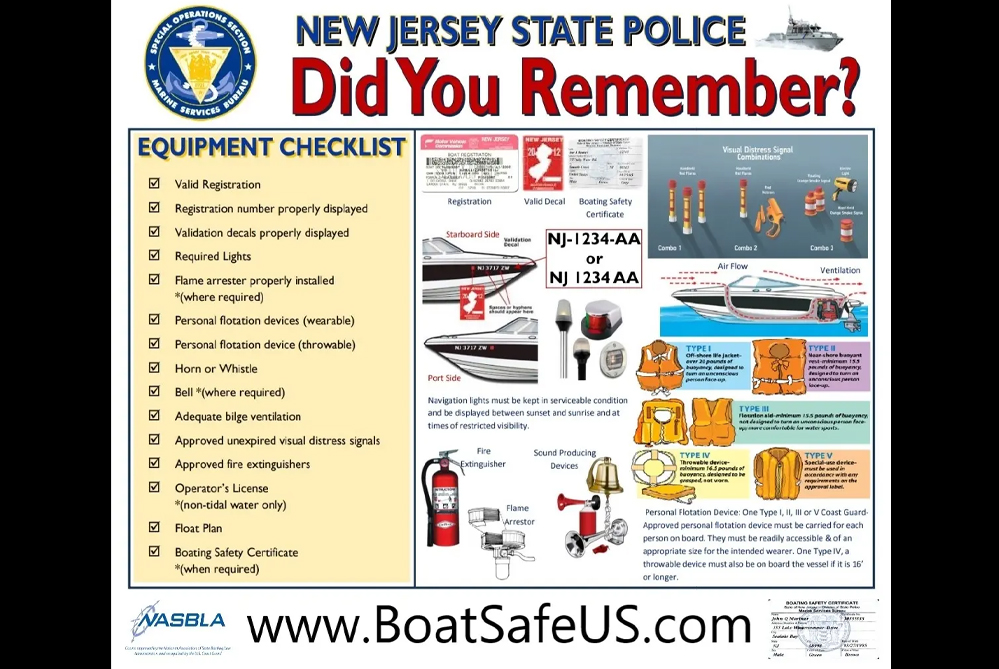With summer just around the corner, it’s time to gear up for another fantastic boating season on New Jersey’s waterways. Before you set sail, take some time to prepare your paperwork and equipment. Ensuring you have the appropriate gear in working order will save you a lot of hassle once you’re ready to hit the water.

The New Jersey State Police (NJSP) has provided a comprehensive checklist to help boaters stay prepared. You can find it here: NJSP Boating Equipment Checklist. For detailed information on boating rules and regulations in NJ, refer to the NJSP Boating Safety Manual.
Here’s a summary of the essentials you’ll need:
1. Valid Registration
- Ensure your boat is registered. If not, start with the MVC Application for Boat Registration.
2. Registration Number Display
- Your boat’s registration number must be properly displayed, with spaces between the NJ prefix, the four numbers, and the two-letter suffix. The registration decal should be placed aft of the letters and numbers on each side of the boat.
3. Validation Decals
- Display validation stickers three inches behind the State registration number on each side of the vessel.
4. Required Lights
- Boats operating at night must display navigation lights between sunset and sunrise. Ensure you have the correct lights for your boat size and that they are functional.
5. Flame Arrester
- Gasoline engines (excluding outboard motors) must have a U.S. Coast Guard approved flame arrester fitted to the carburetor.
6. Personal Flotation Devices (Wearable)
- Every vessel must have one USCG-approved wearable PFD (Type I, II, III, or V) for each person on board or being towed. Check for tears and wear, and replace any damaged PFDs.
7. Personal Flotation Device (Throwable)
- Vessels 16 feet or longer (excluding canoes and kayaks) must carry one USCG-approved throwable Type IV device. Ensure it’s in good condition.
8. Horn or Whistle
- Verify that you have a functional horn or whistle on board.
9. Bell
- If required, make sure you have a working bell.
10. Adequate Bilge Ventilation
- Ensure there is at least one exhaust duct extending to the lower portion of the bilge and one intake duct reaching at least midway to the bilge or below the level of the carburetor air intake.
11. Approved Unexpired Visual Distress Signals
- Check the expiration date on your flares and replace them if necessary.
12. Approved Fire Extinguishers
- Confirm that your fire extinguishers are approved for marine use and check their expiration dates.
13. Operator’s License (Non-tidal Water Only)
- Known as a “non-tidal boat license,” this is your NJ driver’s license with a “BOAT” endorsement. For non-tidal waters, obtain your boat safety certificate and visit an NJ Motor Vehicles Agency to update your license.
14. Float Plan
- Plan who will have your float plan information. Here’s an example of what to include: US Coast Guard Float Plan.
15. Boating Safety Certificate
- You need a NJSP-issued boat safety certificate to operate any powered vessel in NJ. Take an approved course and pass the proctored exam. Check the schedule and register for classes and exams at Boat Safe US. You can also complete the course online via Aceboater.com, Boaterexam.com, or Boat-Ed.com, and then join a proctored exam.
Getting everything in order now will ensure a smooth and enjoyable boating season. Happy boating, Cherry Hill!



